Fredrick Douglass: Contribution to Antislavery Movement and Rights
VerifiedAdded on 2023/05/30
|5
|1329
|115
Essay
AI Summary
This essay examines the life and work of Fredrick Douglass, focusing on his significant contributions to the antislavery movement and his advocacy for human rights. It details his background as a former slave, his escape to freedom, and his subsequent rise as a prominent abolitionist leader, speaker, and writer. The essay highlights Douglass's influential writings, particularly his autobiography, "Narrative of the Life of Frederick Douglass, an American Slave," and discusses his impact on shaping public opinion against slavery during the Civil War era. Furthermore, it explores Douglass's continued fight for equality and human rights beyond the abolition of slavery, underscoring his lasting legacy as a champion for social justice and a symbol of the American dream.
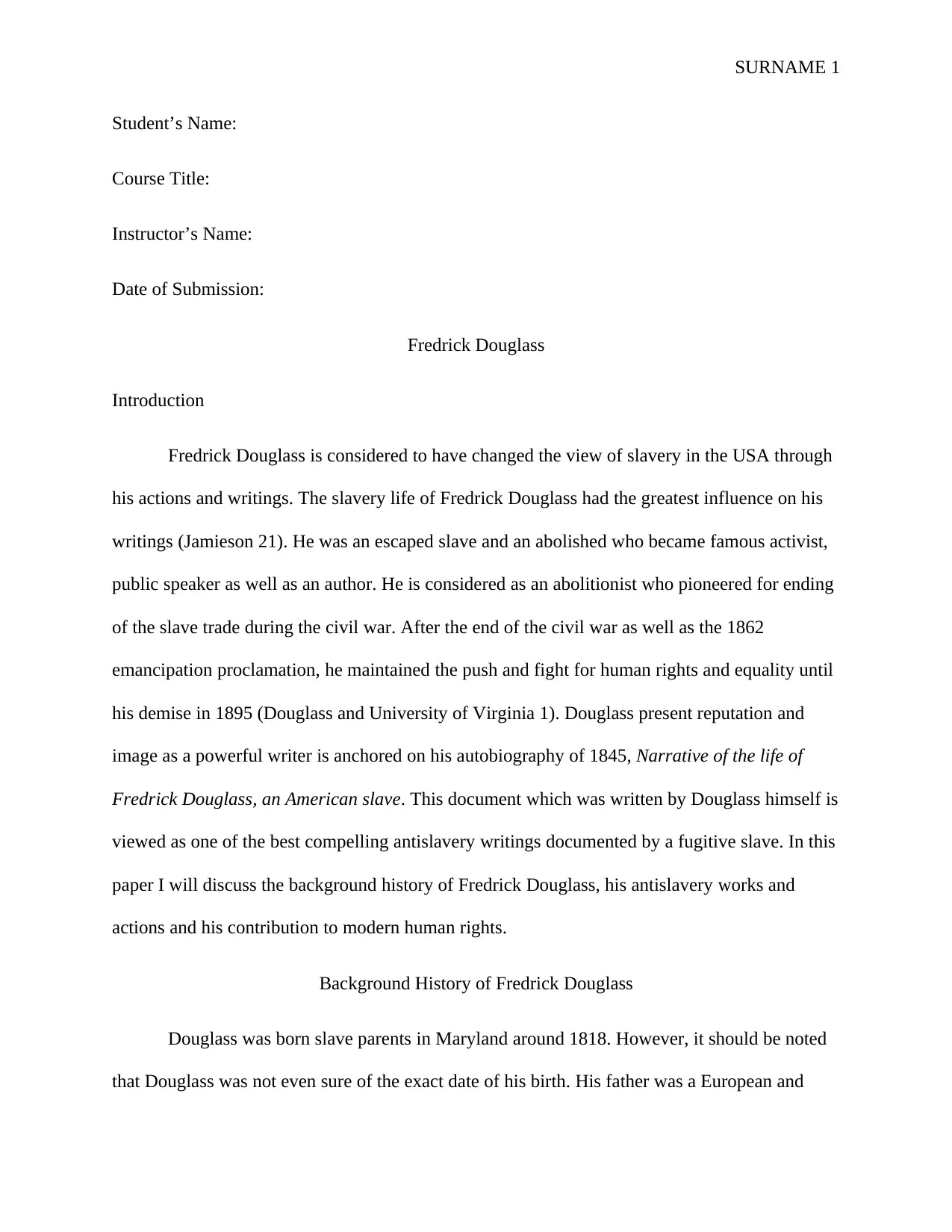
SURNAME 1
Student’s Name:
Course Title:
Instructor’s Name:
Date of Submission:
Fredrick Douglass
Introduction
Fredrick Douglass is considered to have changed the view of slavery in the USA through
his actions and writings. The slavery life of Fredrick Douglass had the greatest influence on his
writings (Jamieson 21). He was an escaped slave and an abolished who became famous activist,
public speaker as well as an author. He is considered as an abolitionist who pioneered for ending
of the slave trade during the civil war. After the end of the civil war as well as the 1862
emancipation proclamation, he maintained the push and fight for human rights and equality until
his demise in 1895 (Douglass and University of Virginia 1). Douglass present reputation and
image as a powerful writer is anchored on his autobiography of 1845, Narrative of the life of
Fredrick Douglass, an American slave. This document which was written by Douglass himself is
viewed as one of the best compelling antislavery writings documented by a fugitive slave. In this
paper I will discuss the background history of Fredrick Douglass, his antislavery works and
actions and his contribution to modern human rights.
Background History of Fredrick Douglass
Douglass was born slave parents in Maryland around 1818. However, it should be noted
that Douglass was not even sure of the exact date of his birth. His father was a European and
Student’s Name:
Course Title:
Instructor’s Name:
Date of Submission:
Fredrick Douglass
Introduction
Fredrick Douglass is considered to have changed the view of slavery in the USA through
his actions and writings. The slavery life of Fredrick Douglass had the greatest influence on his
writings (Jamieson 21). He was an escaped slave and an abolished who became famous activist,
public speaker as well as an author. He is considered as an abolitionist who pioneered for ending
of the slave trade during the civil war. After the end of the civil war as well as the 1862
emancipation proclamation, he maintained the push and fight for human rights and equality until
his demise in 1895 (Douglass and University of Virginia 1). Douglass present reputation and
image as a powerful writer is anchored on his autobiography of 1845, Narrative of the life of
Fredrick Douglass, an American slave. This document which was written by Douglass himself is
viewed as one of the best compelling antislavery writings documented by a fugitive slave. In this
paper I will discuss the background history of Fredrick Douglass, his antislavery works and
actions and his contribution to modern human rights.
Background History of Fredrick Douglass
Douglass was born slave parents in Maryland around 1818. However, it should be noted
that Douglass was not even sure of the exact date of his birth. His father was a European and
Paraphrase This Document
Need a fresh take? Get an instant paraphrase of this document with our AI Paraphraser
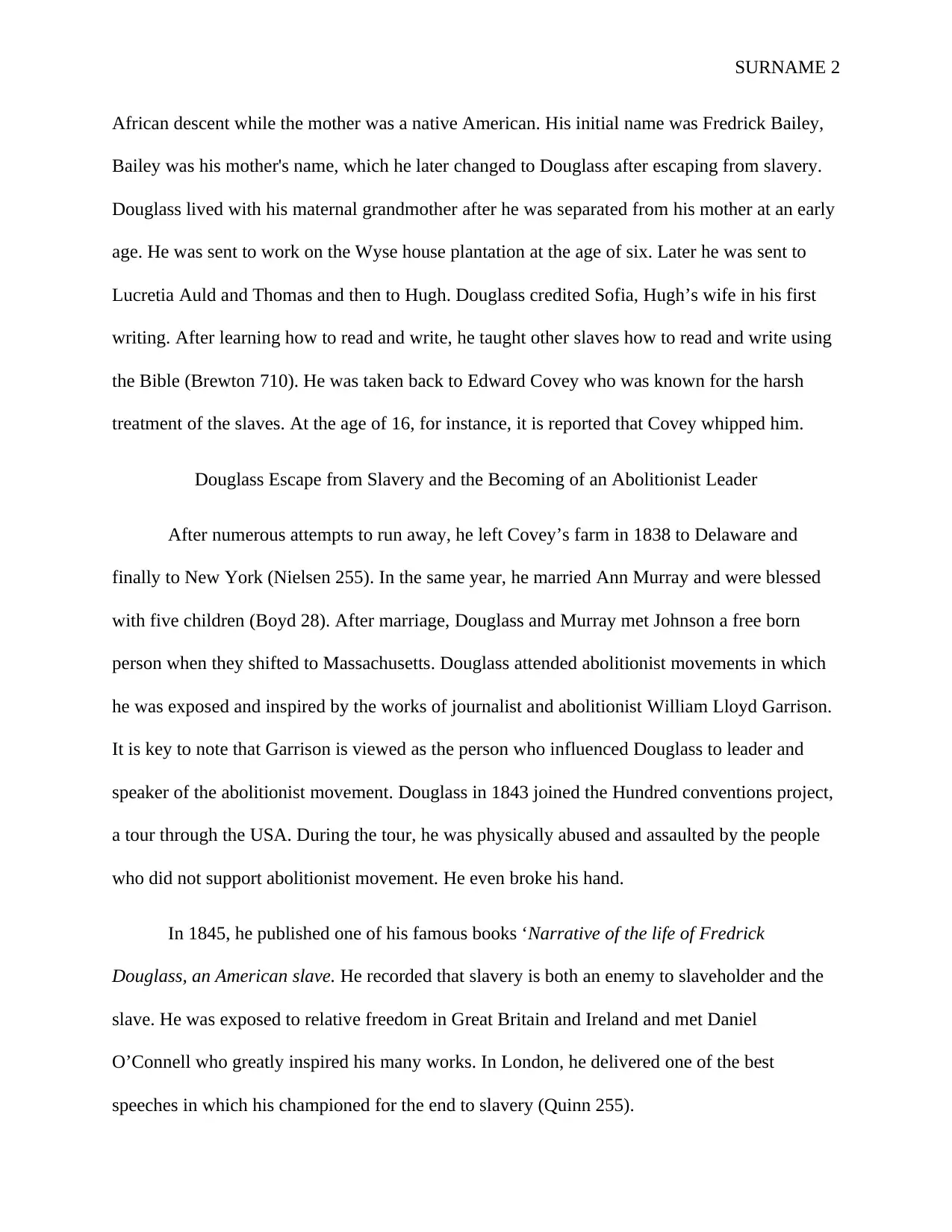
SURNAME 2
African descent while the mother was a native American. His initial name was Fredrick Bailey,
Bailey was his mother's name, which he later changed to Douglass after escaping from slavery.
Douglass lived with his maternal grandmother after he was separated from his mother at an early
age. He was sent to work on the Wyse house plantation at the age of six. Later he was sent to
Lucretia Auld and Thomas and then to Hugh. Douglass credited Sofia, Hugh’s wife in his first
writing. After learning how to read and write, he taught other slaves how to read and write using
the Bible (Brewton 710). He was taken back to Edward Covey who was known for the harsh
treatment of the slaves. At the age of 16, for instance, it is reported that Covey whipped him.
Douglass Escape from Slavery and the Becoming of an Abolitionist Leader
After numerous attempts to run away, he left Covey’s farm in 1838 to Delaware and
finally to New York (Nielsen 255). In the same year, he married Ann Murray and were blessed
with five children (Boyd 28). After marriage, Douglass and Murray met Johnson a free born
person when they shifted to Massachusetts. Douglass attended abolitionist movements in which
he was exposed and inspired by the works of journalist and abolitionist William Lloyd Garrison.
It is key to note that Garrison is viewed as the person who influenced Douglass to leader and
speaker of the abolitionist movement. Douglass in 1843 joined the Hundred conventions project,
a tour through the USA. During the tour, he was physically abused and assaulted by the people
who did not support abolitionist movement. He even broke his hand.
In 1845, he published one of his famous books ‘Narrative of the life of Fredrick
Douglass, an American slave. He recorded that slavery is both an enemy to slaveholder and the
slave. He was exposed to relative freedom in Great Britain and Ireland and met Daniel
O’Connell who greatly inspired his many works. In London, he delivered one of the best
speeches in which his championed for the end to slavery (Quinn 255).
African descent while the mother was a native American. His initial name was Fredrick Bailey,
Bailey was his mother's name, which he later changed to Douglass after escaping from slavery.
Douglass lived with his maternal grandmother after he was separated from his mother at an early
age. He was sent to work on the Wyse house plantation at the age of six. Later he was sent to
Lucretia Auld and Thomas and then to Hugh. Douglass credited Sofia, Hugh’s wife in his first
writing. After learning how to read and write, he taught other slaves how to read and write using
the Bible (Brewton 710). He was taken back to Edward Covey who was known for the harsh
treatment of the slaves. At the age of 16, for instance, it is reported that Covey whipped him.
Douglass Escape from Slavery and the Becoming of an Abolitionist Leader
After numerous attempts to run away, he left Covey’s farm in 1838 to Delaware and
finally to New York (Nielsen 255). In the same year, he married Ann Murray and were blessed
with five children (Boyd 28). After marriage, Douglass and Murray met Johnson a free born
person when they shifted to Massachusetts. Douglass attended abolitionist movements in which
he was exposed and inspired by the works of journalist and abolitionist William Lloyd Garrison.
It is key to note that Garrison is viewed as the person who influenced Douglass to leader and
speaker of the abolitionist movement. Douglass in 1843 joined the Hundred conventions project,
a tour through the USA. During the tour, he was physically abused and assaulted by the people
who did not support abolitionist movement. He even broke his hand.
In 1845, he published one of his famous books ‘Narrative of the life of Fredrick
Douglass, an American slave. He recorded that slavery is both an enemy to slaveholder and the
slave. He was exposed to relative freedom in Great Britain and Ireland and met Daniel
O’Connell who greatly inspired his many works. In London, he delivered one of the best
speeches in which his championed for the end to slavery (Quinn 255).
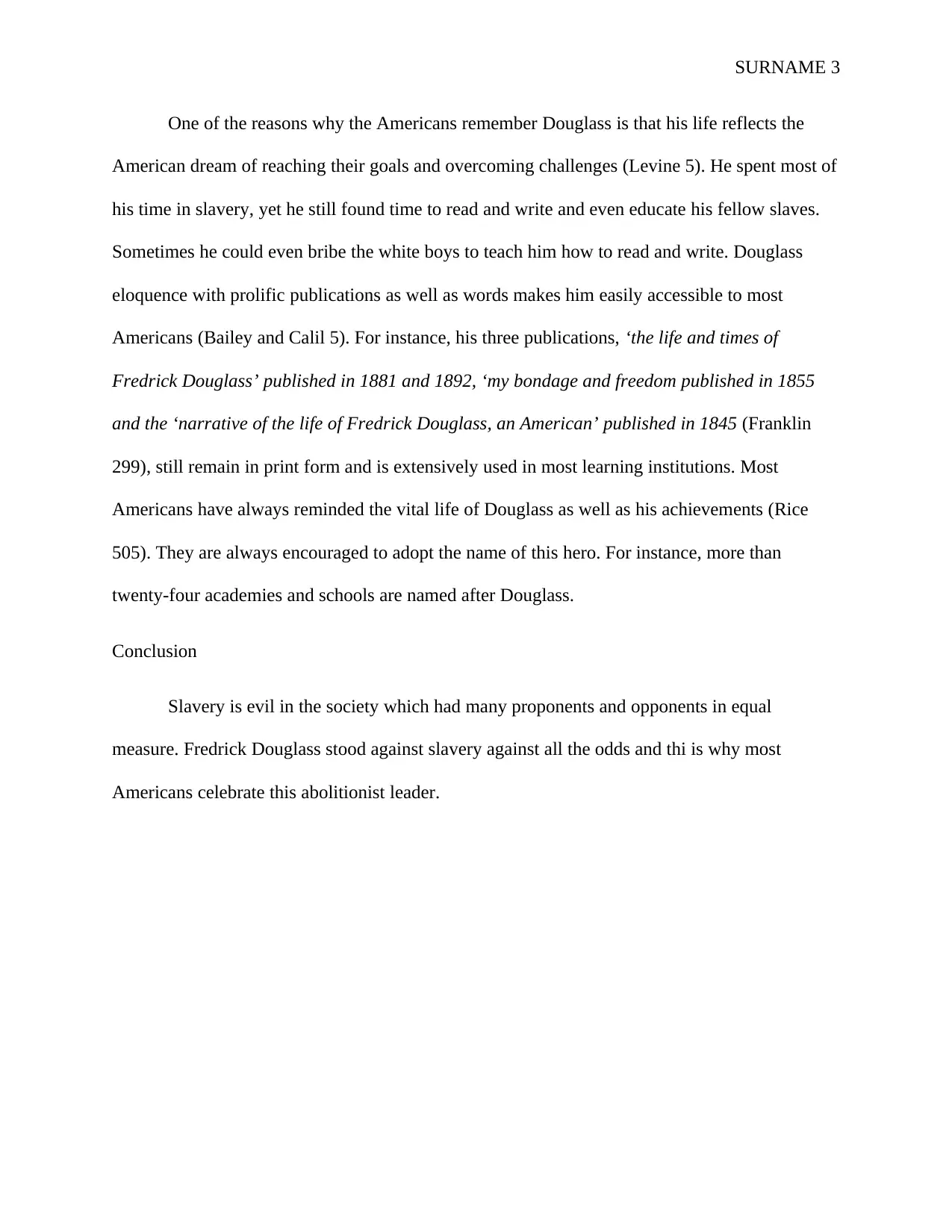
SURNAME 3
One of the reasons why the Americans remember Douglass is that his life reflects the
American dream of reaching their goals and overcoming challenges (Levine 5). He spent most of
his time in slavery, yet he still found time to read and write and even educate his fellow slaves.
Sometimes he could even bribe the white boys to teach him how to read and write. Douglass
eloquence with prolific publications as well as words makes him easily accessible to most
Americans (Bailey and Calil 5). For instance, his three publications, ‘the life and times of
Fredrick Douglass’ published in 1881 and 1892, ‘my bondage and freedom published in 1855
and the ‘narrative of the life of Fredrick Douglass, an American’ published in 1845 (Franklin
299), still remain in print form and is extensively used in most learning institutions. Most
Americans have always reminded the vital life of Douglass as well as his achievements (Rice
505). They are always encouraged to adopt the name of this hero. For instance, more than
twenty-four academies and schools are named after Douglass.
Conclusion
Slavery is evil in the society which had many proponents and opponents in equal
measure. Fredrick Douglass stood against slavery against all the odds and thi is why most
Americans celebrate this abolitionist leader.
One of the reasons why the Americans remember Douglass is that his life reflects the
American dream of reaching their goals and overcoming challenges (Levine 5). He spent most of
his time in slavery, yet he still found time to read and write and even educate his fellow slaves.
Sometimes he could even bribe the white boys to teach him how to read and write. Douglass
eloquence with prolific publications as well as words makes him easily accessible to most
Americans (Bailey and Calil 5). For instance, his three publications, ‘the life and times of
Fredrick Douglass’ published in 1881 and 1892, ‘my bondage and freedom published in 1855
and the ‘narrative of the life of Fredrick Douglass, an American’ published in 1845 (Franklin
299), still remain in print form and is extensively used in most learning institutions. Most
Americans have always reminded the vital life of Douglass as well as his achievements (Rice
505). They are always encouraged to adopt the name of this hero. For instance, more than
twenty-four academies and schools are named after Douglass.
Conclusion
Slavery is evil in the society which had many proponents and opponents in equal
measure. Fredrick Douglass stood against slavery against all the odds and thi is why most
Americans celebrate this abolitionist leader.
⊘ This is a preview!⊘
Do you want full access?
Subscribe today to unlock all pages.

Trusted by 1+ million students worldwide
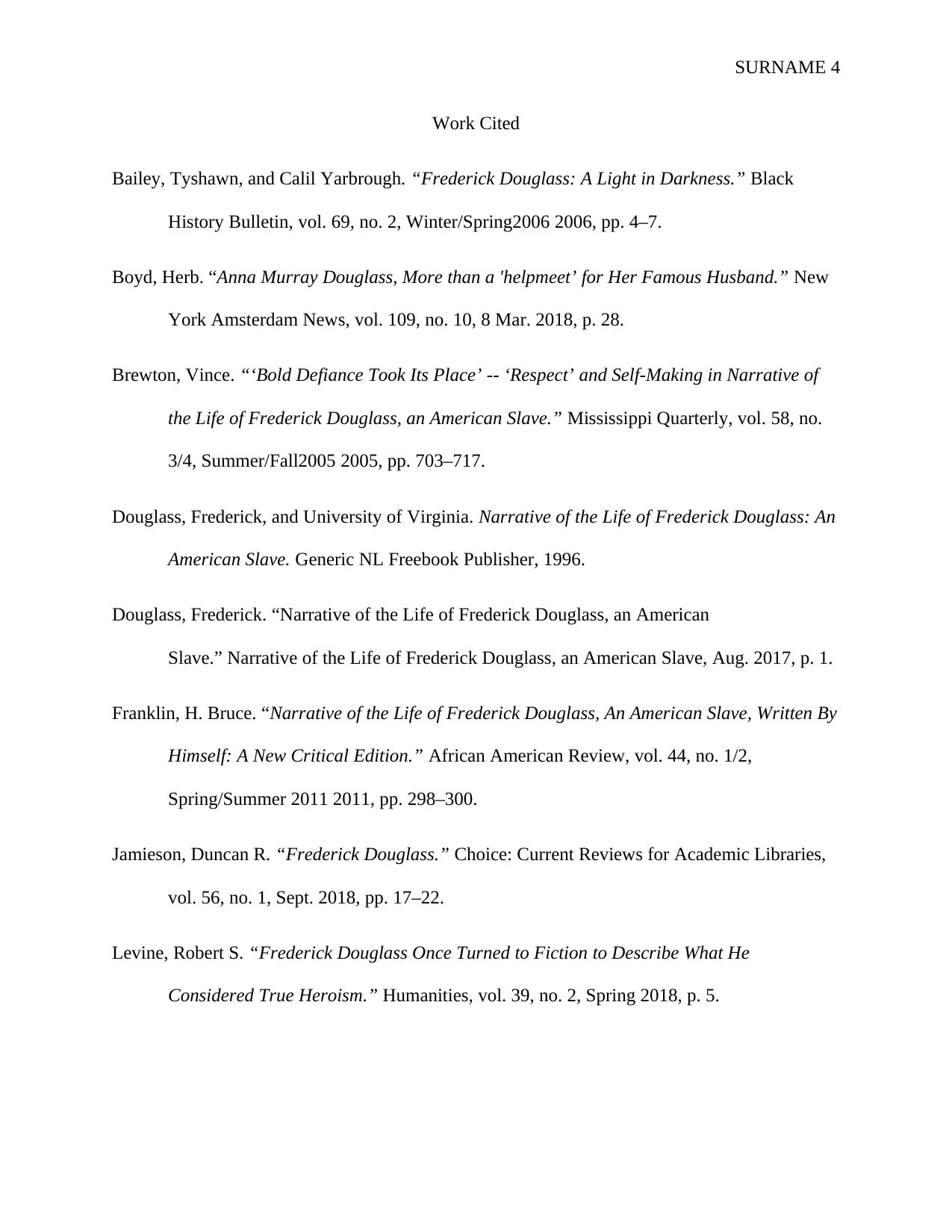
SURNAME 4
Work Cited
Bailey, Tyshawn, and Calil Yarbrough. “Frederick Douglass: A Light in Darkness.” Black
History Bulletin, vol. 69, no. 2, Winter/Spring2006 2006, pp. 4–7.
Boyd, Herb. “Anna Murray Douglass, More than a 'helpmeet’ for Her Famous Husband.” New
York Amsterdam News, vol. 109, no. 10, 8 Mar. 2018, p. 28.
Brewton, Vince. “‘Bold Defiance Took Its Place’ -- ‘Respect’ and Self-Making in Narrative of
the Life of Frederick Douglass, an American Slave.” Mississippi Quarterly, vol. 58, no.
3/4, Summer/Fall2005 2005, pp. 703–717.
Douglass, Frederick, and University of Virginia. Narrative of the Life of Frederick Douglass: An
American Slave. Generic NL Freebook Publisher, 1996.
Douglass, Frederick. “Narrative of the Life of Frederick Douglass, an American
Slave.” Narrative of the Life of Frederick Douglass, an American Slave, Aug. 2017, p. 1.
Franklin, H. Bruce. “Narrative of the Life of Frederick Douglass, An American Slave, Written By
Himself: A New Critical Edition.” African American Review, vol. 44, no. 1/2,
Spring/Summer 2011 2011, pp. 298–300.
Jamieson, Duncan R. “Frederick Douglass.” Choice: Current Reviews for Academic Libraries,
vol. 56, no. 1, Sept. 2018, pp. 17–22.
Levine, Robert S. “Frederick Douglass Once Turned to Fiction to Describe What He
Considered True Heroism.” Humanities, vol. 39, no. 2, Spring 2018, p. 5.
Work Cited
Bailey, Tyshawn, and Calil Yarbrough. “Frederick Douglass: A Light in Darkness.” Black
History Bulletin, vol. 69, no. 2, Winter/Spring2006 2006, pp. 4–7.
Boyd, Herb. “Anna Murray Douglass, More than a 'helpmeet’ for Her Famous Husband.” New
York Amsterdam News, vol. 109, no. 10, 8 Mar. 2018, p. 28.
Brewton, Vince. “‘Bold Defiance Took Its Place’ -- ‘Respect’ and Self-Making in Narrative of
the Life of Frederick Douglass, an American Slave.” Mississippi Quarterly, vol. 58, no.
3/4, Summer/Fall2005 2005, pp. 703–717.
Douglass, Frederick, and University of Virginia. Narrative of the Life of Frederick Douglass: An
American Slave. Generic NL Freebook Publisher, 1996.
Douglass, Frederick. “Narrative of the Life of Frederick Douglass, an American
Slave.” Narrative of the Life of Frederick Douglass, an American Slave, Aug. 2017, p. 1.
Franklin, H. Bruce. “Narrative of the Life of Frederick Douglass, An American Slave, Written By
Himself: A New Critical Edition.” African American Review, vol. 44, no. 1/2,
Spring/Summer 2011 2011, pp. 298–300.
Jamieson, Duncan R. “Frederick Douglass.” Choice: Current Reviews for Academic Libraries,
vol. 56, no. 1, Sept. 2018, pp. 17–22.
Levine, Robert S. “Frederick Douglass Once Turned to Fiction to Describe What He
Considered True Heroism.” Humanities, vol. 39, no. 2, Spring 2018, p. 5.
Paraphrase This Document
Need a fresh take? Get an instant paraphrase of this document with our AI Paraphraser
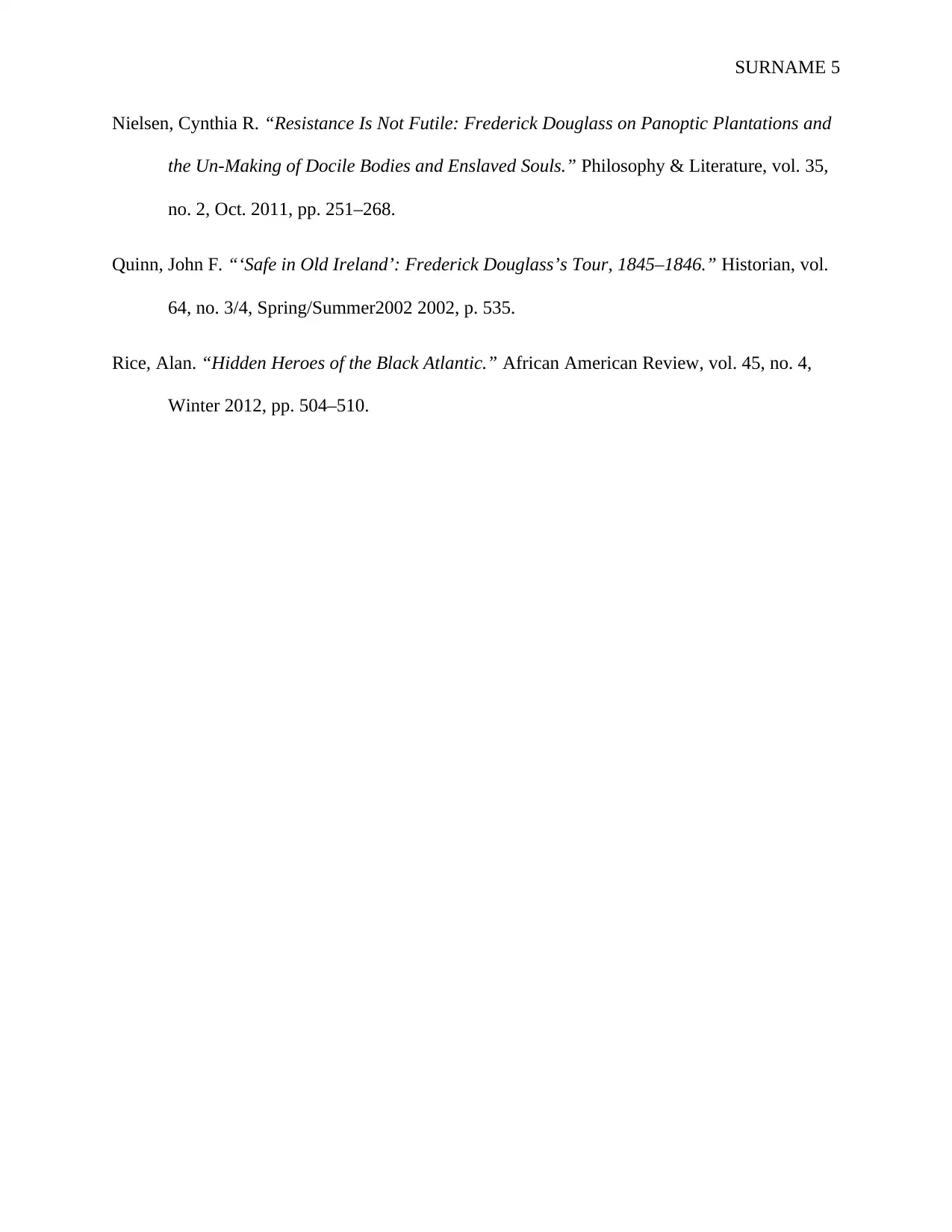
SURNAME 5
Nielsen, Cynthia R. “Resistance Is Not Futile: Frederick Douglass on Panoptic Plantations and
the Un-Making of Docile Bodies and Enslaved Souls.” Philosophy & Literature, vol. 35,
no. 2, Oct. 2011, pp. 251–268.
Quinn, John F. “‘Safe in Old Ireland’: Frederick Douglass’s Tour, 1845–1846.” Historian, vol.
64, no. 3/4, Spring/Summer2002 2002, p. 535.
Rice, Alan. “Hidden Heroes of the Black Atlantic.” African American Review, vol. 45, no. 4,
Winter 2012, pp. 504–510.
Nielsen, Cynthia R. “Resistance Is Not Futile: Frederick Douglass on Panoptic Plantations and
the Un-Making of Docile Bodies and Enslaved Souls.” Philosophy & Literature, vol. 35,
no. 2, Oct. 2011, pp. 251–268.
Quinn, John F. “‘Safe in Old Ireland’: Frederick Douglass’s Tour, 1845–1846.” Historian, vol.
64, no. 3/4, Spring/Summer2002 2002, p. 535.
Rice, Alan. “Hidden Heroes of the Black Atlantic.” African American Review, vol. 45, no. 4,
Winter 2012, pp. 504–510.
1 out of 5
Your All-in-One AI-Powered Toolkit for Academic Success.
+13062052269
info@desklib.com
Available 24*7 on WhatsApp / Email
![[object Object]](/_next/static/media/star-bottom.7253800d.svg)
Unlock your academic potential
Copyright © 2020–2025 A2Z Services. All Rights Reserved. Developed and managed by ZUCOL.

